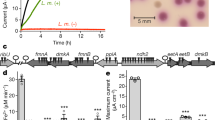Abstract.
Results from several laboratories indicate that extracellular electron transfer may be a general mechanism whereby microoorganisms generate energy for cell growth and/or maintenance. Specifically, bacteria can use redox-active organic small molecules, generated outside or inside the cells, to shuttle electrons between reduced and oxidized compounds. Electron shuttling has now been reported for several different bacterial species, and exchanges of shuttling compounds may even syntrophically link diverse organisms in nature. Biofilm systems in both geological and clinical settings are likely to be important environments for metabolisms that employ extracellular electron transfer. Both structural and functional analyses suggest that electron shuttles and some virulence factors may be related to one another.
Similar content being viewed by others
Author information
Authors and Affiliations
Additional information
Received 21 March 2001; received after revision 10 May 2001; accepted 11 May 2001
Rights and permissions
About this article
Cite this article
Hernandez, M., Newman, D. Extracellular electron transfer. CMLS, Cell. Mol. Life Sci. 58, 1562–1571 (2001). https://doi.org/10.1007/PL00000796
Issue Date:
DOI: https://doi.org/10.1007/PL00000796




